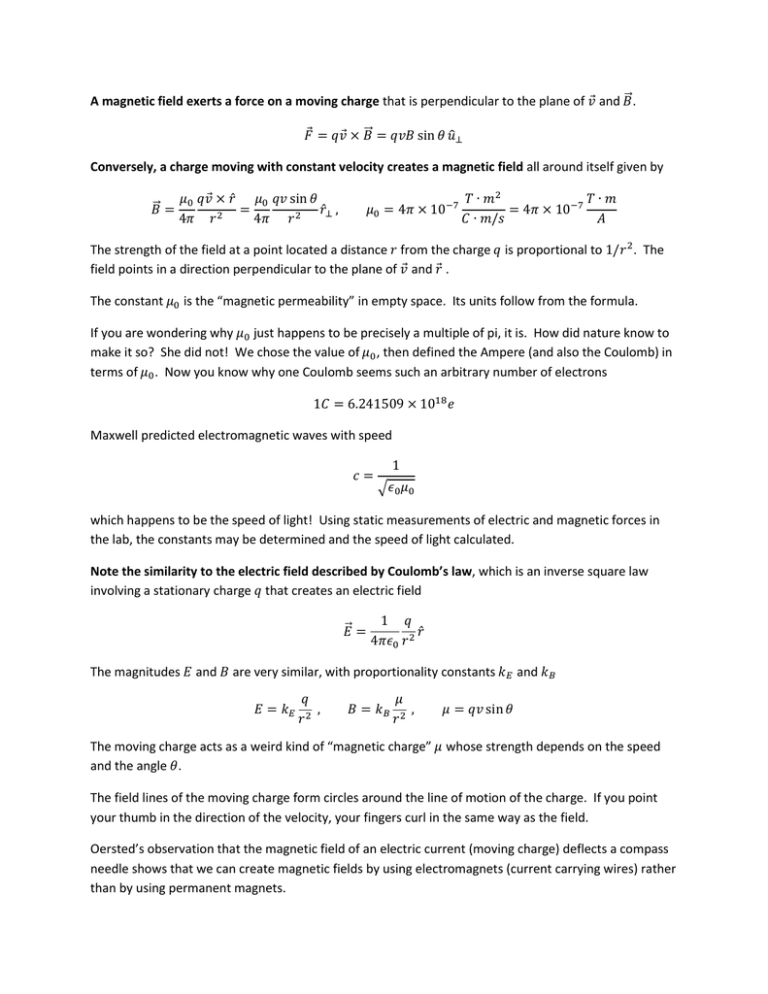A magnetic field exerts a force on a moving charge that is
advertisement

A magnetic field exerts a force on a moving charge that is perpendicular to the plane of ⃗ and ⃗⃗. ⃗ ⃗ ⃗⃗ ̂ Conversely, a charge moving with constant velocity creates a magnetic field all around itself given by ⃗⃗ ⃗ ̂ ̂ The strength of the field at a point located a distance from the charge field points in a direction perpendicular to the plane of ⃗ and ⃗ . The constant is proportional to . The is the “magnetic permeability” in empty space. Its units follow from the formula. If you are wondering why just happens to be precisely a multiple of pi, it is. How did nature know to make it so? She did not! We chose the value of , then defined the Ampere (and also the Coulomb) in terms of . Now you know why one Coulomb seems such an arbitrary number of electrons Maxwell predicted electromagnetic waves with speed √ which happens to be the speed of light! Using static measurements of electric and magnetic forces in the lab, the constants may be determined and the speed of light calculated. Note the similarity to the electric field described by Coulomb’s law, which is an inverse square law involving a stationary charge that creates an electric field ⃗⃗ The magnitudes and ̂ are very similar, with proportionality constants The moving charge acts as a weird kind of “magnetic charge” and the angle . and whose strength depends on the speed The field lines of the moving charge form circles around the line of motion of the charge. If you point your thumb in the direction of the velocity, your fingers curl in the same way as the field. Oersted’s observation that the magnetic field of an electric current (moving charge) deflects a compass needle shows that we can create magnetic fields by using electromagnets (current carrying wires) rather than by using permanent magnets. ⃗⃗. We are already familiar with “current A magnetic field is created by an electric current element element” from our study of the force of a magnetic field ⃗⃗ on a current carrying wire ⃗ ⃗⃗ ⃗⃗ ̂ where ⃗⃗ is a vector length that gets its direction from the direction of the current. Now we find the field produced by a current element. The formula for the field of a moving charge can be written for an infinitesimal element of charge ⃗ ⃗⃗ ⃗⃗ for By substituting ̂ ⃗ ⃗⃗ ⃗ ⃗⃗ ⃗⃗ we obtain ⃗⃗ ⃗⃗ The product ̂ ⃗⃗ of a current element. ⃗ of a moving charge is the same as the product A current carrying wire can be divided into an infinite number of infinitesimal vector lengths ⃗⃗. The field created by the wire is then the infinite sum, the integral ⃗⃗ ∫ ⃗⃗ ⃗⃗ ∫ ̂ The field of a long current carrying wire is approximately equal to the field of an infinitely long current carrying wire (see Y&F figure 28.5). By the right hand rule we see that each current element produces an element of field pointing in the direction at a point . Summing over a length of wire from ⃗⃗ ∫ ⃗ ̂ to ( ̂) ∫ The integral is a calculus exercise and can be found in a table of integrals ∫ ∫ ( ) √ ( ) ̂ If (the case of a long wire), the ratio formula for an infinitely long wire is ⃗⃗ ( is very small and can be neglected. Letting ) ̂ the ̂ ⃗⃗ Two parallel current carrying wires exert forces on one another. A current carrying wire creates a magnetic field. The field exerts a force on another current carrying wire. The force of a uniform magnetic field on a length of current carrying wire is For parallel wires, the field created by one wire has the same strength and direction at all points along the other wire. The field of the second wire may be written where is the distance between the wires. In terms of this field the force on wire 1 is Similarly, the field of wire 1 exerts a force on wire 2 of exactly the same magnitude By the right hand rule it is easy to see that the forces are in opposite directions, so we have a case of two bodies exerting equal and opposite forces on one another, in agreement with Newton’s third law. The force per unit length is The ampere is defined to be the current that creates a force per meter length of magnitude √ for parallel wires one meter apart. The coulomb unit of charge follows from the ampere.




